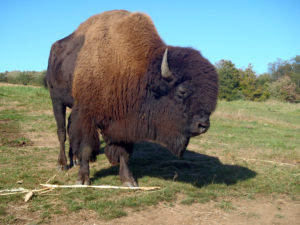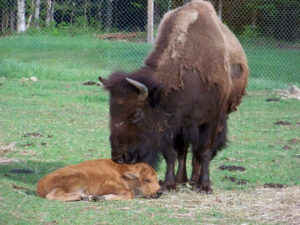Where the Buffalo Roam
Our little family farm is tucked away in a remote corner of Tug Hill in the Adirondack region of upstate NY. As a child I lived on a small family farm, where I learned to have a strong work ethic and an even stronger understanding of our family values. As I grew up, went to college, married and started a family of my own, I realized I wanted my children to have those same experiences and values. Raising bison, the more accurate name for our animals, is no small chore and should not be entered into lightly. That being said – we couldn’t be happier. Bison are absolutely amazing creatures, each with their own personality. They are majestic wild animals.
Fun Facts About Bison
- Bison are faster and more agile than a horse, running at 40 mph and jumping 6 feet high.
- Bison are matriarchal, meaning a female will be the head of the herd.
- One Bison bull can usually service 10-18 cows.
- Bison live 20-25 years in the wild and up to 30 in quality captive conditions.
More than 60 million bison once roamed all across the North American Continent. Bison have thrived on wild and drought resistant grasses, native shrubs, flowers and other plants and were a huge part of the ecological system. Bison are considered ruminants, as they do chew a cud. To Native Americans bison were the economic and spiritual sustenance, supplying them with food, clothing, shelter and a source of utensils and tools. Currently, there are approximately 500,000 bison in the US. Yellowstone National Park has a herd of about 3,500 wild bison, making it the largest wild herd in the world.
Bison are not tame animals and must be handled with care and caution, each with their own personality. While they may seem quiet or docile, they should not be trusted. Respect them and give them their needed space. Proper handling equipment, fencing and patience are must haves. Our fence posts are telephone poles or 6X6’s- 12 feet long, buried 4 feet down and a woven wire fence 8 feet high. The bison pasture ratio is the same as that for cows, which is readily available through your local cooperative extension.
We will be moving to a rotational grazing system this year in an effort to adopt more sustainable practices. We currently have about 27 bison ranging in age from newborns to fully mature animals. Our plans are to continue to grow our farm as we can. Currently we sell our bison meat to family, friends and our local community. With just word-of-mouth advertising, we can’t meet the local demand. We plan to join some of the local Farmers Markets as our growth allows.
Our customers come from diverse backgrounds. They range from people curious about the taste of an exotic meat, outdoorsmen, Buy Local folks, and those interested in a healthier red meat.
After taking to a variety of people including our potential customers, we have opted to transport our bison alive more than 3 hours away to a plant capable of processing them with a USDA inspection process. This is not required but is viewed as a valuable quality control for our customers. We have also had people interested in purchasing live animals on the hoof for private processing.
We love all of our animals and take comfort in knowing they are raised in a healthy manner where they can run and play in a natural environment. We have also chosen not to use antibiotics or hormones with our bison. They are hearty animals with a strong resistance to many diseases and we feel that nature should not be tampered with.

George is our productive bull right now.
A common belief is that ranchers breed bison with cattle. This is not true. ”The National Bison Association is dedicated to maintaining the integrity species. In fact, our Code of Ethics specifically prohibits members from deliberately crossbreeding bison with another species.”
We chose bison because of its wonderful meat. It is delicious and nutritious.
According to the Nation Bison Association, bison are classified as an exotic, or “non-amenable species,” under the Federal Meat Inspection Act. As such, they fall under some unique regulatory provisions. All bison marketed into the commercial marketplace must be processed in an FDA-approved facility. These facilities are required to comply with all FDA regulations, as well as with the FSIS regulations regarding sanitation. Bison producers/processors may also request “voluntary inspection” services from the U.S. Department of Agriculture’s Food Safety and Inspections Service (FSIS) or from a an accredited state-inspection program which offers inspection “at least equal” to USDA.
There are a numbers of farms in the central New York area that sell live animals for those interested in raising bison. The Eastern Bison Association also hosts two conferences/shows and sales annually.
To learn more about raising bison, visit The National Bison Association website.



How exciting. Your right down the road from my camp. Could I stop by and get info on meat. My kids love watching them.